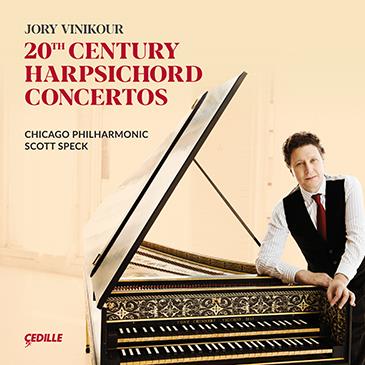by Daniel Hathaway

Vinikour has opted to use copies by Tony Chinnery and Paul Irvin after historic French and Franco-Flemish instruments instead of the piano-influenced machines invented by Pleyel and others at the beginning of that period. As he writes in his liner notes, “The richer sound of such instruments is, in my opinion, better suited to recording.”
British composer Walter Leigh studied with Paul Hindemith, whose influence shows in his Concertino for Harpsichord and Strings. The first of its three movements pits an energetic solo part against rich string textures in charged conversations and gives Vinikour a big, busy cadenza. A sospiri (sighing) motive permeates the slow movement and the work ends with an angular gigue featuring leaping motives in the strings.
Ned Rorem’s 1943 Concertino da Camera lay forgotten in a trunk for 73 years before it was finally debuted in 1993. Beginning lyrically, it suddenly takes off running amid trumpet and wind flourishes, sprightly textures, and a wild cadenza. The slow movement is tinged with Copland, while the finale, marked “Gigue,” moves in the direction of a reel. Rorem’s light scoring — violin, viola, cello, flute, oboe, bassoon and cornet, similar to the de Falla concerto — carves out plenty of space for the harpsichord to be heard.
Czech composer Viktor Kalabis’ Concerto for Harpsichord and Strings (1974-5) was inspired by his marriage to harpsichordist Zuzana Růžičková, who was looking for “something cheerful,” but might have been a bit surprised by the results. The work, which has been interpreted as an unresolved struggle between personal expression and the forces of oppression, features a “rhetorical” solo cadenza and frenetic moments juxtaposed with calm episodes.
Intentional sound reinforcement comes into play on the final work, Michael Nyman’s Concerto for Amplified Harpsichord and Strings. Frenetic, jazzy, jangly, sometimes almost threatening, the piece calls for steely resolve from the harpsichordist (it was written for Franco-Polish artist Elisabeth Chojinacka), and Vinikour supplies that tirelessly. The fifth-movement cadenza is fully as virtuosic as the toccata that ends Prokofiev’s Seventh Piano Sonata.
Jory Vinikour’s masterful playing distinguishes this album, but his elaborate and very personal program notes are a real bonus. Unusually, all his collaborators are credited in the roster of performers — a nice touch that not only personalizes the album but adds to its archival value.
Published on ClevelandClassical.com December 13, 2019.
Click here for a printable copy of this article



